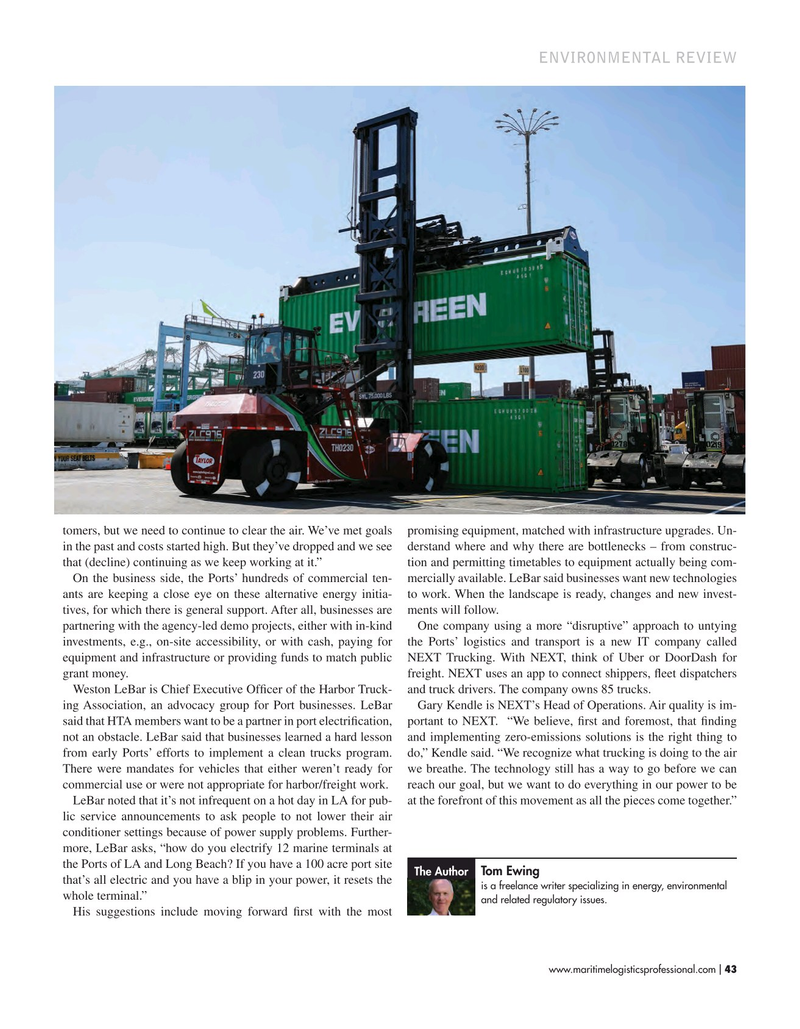
Page 43: of Maritime Logistics Professional Magazine (Sep/Oct 2019)
Energy Ports Oil-Gas-LNG
Read this page in Pdf, Flash or Html5 edition of Sep/Oct 2019 Maritime Logistics Professional Magazine
ENVIRONMENTAL REVIEW tomers, but we need to continue to clear the air. We’ve met goals promising equipment, matched with infrastructure upgrades. Un- in the past and costs started high. But they’ve dropped and we see derstand where and why there are bottlenecks – from construc- that (decline) continuing as we keep working at it.” tion and permitting timetables to equipment actually being com-
On the business side, the Ports’ hundreds of commercial ten- mercially available. LeBar said businesses want new technologies ants are keeping a close eye on these alternative energy initia- to work. When the landscape is ready, changes and new invest- tives, for which there is general support. After all, businesses are ments will follow.
partnering with the agency-led demo projects, either with in-kind One company using a more “disruptive” approach to untying investments, e.g., on-site accessibility, or with cash, paying for the Ports’ logistics and transport is a new IT company called equipment and infrastructure or providing funds to match public NEXT Trucking. With NEXT, think of Uber or DoorDash for grant money. freight. NEXT uses an app to connect shippers, feet dispatchers
Weston LeBar is Chief Executive Offcer of the Harbor Truck- and truck drivers. The company owns 85 trucks.
ing Association, an advocacy group for Port businesses. LeBar Gary Kendle is NEXT’s Head of Operations. Air quality is im- said that HTA members want to be a partner in port electrifcation, portant to NEXT. “We believe, frst and foremost, that fnding not an obstacle. LeBar said that businesses learned a hard lesson and implementing zero-emissions solutions is the right thing to from early Ports’ efforts to implement a clean trucks program. do,” Kendle said. “We recognize what trucking is doing to the air
There were mandates for vehicles that either weren’t ready for we breathe. The technology still has a way to go before we can commercial use or were not appropriate for harbor/freight work. reach our goal, but we want to do everything in our power to be
LeBar noted that it’s not infrequent on a hot day in LA for pub- at the forefront of this movement as all the pieces come together.” lic service announcements to ask people to not lower their air conditioner settings because of power supply problems. Further- more, LeBar asks, “how do you electrify 12 marine terminals at the Ports of LA and Long Beach? If you have a 100 acre port site
Tom Ewing
The Author that’s all electric and you have a blip in your power, it resets the is a freelance writer specializing in energy, environmental whole terminal.” and related regulatory issues.
His suggestions include moving forward frst with the most www.maritimelogisticsprofessional.com 43
I

 42
42

 44
44
